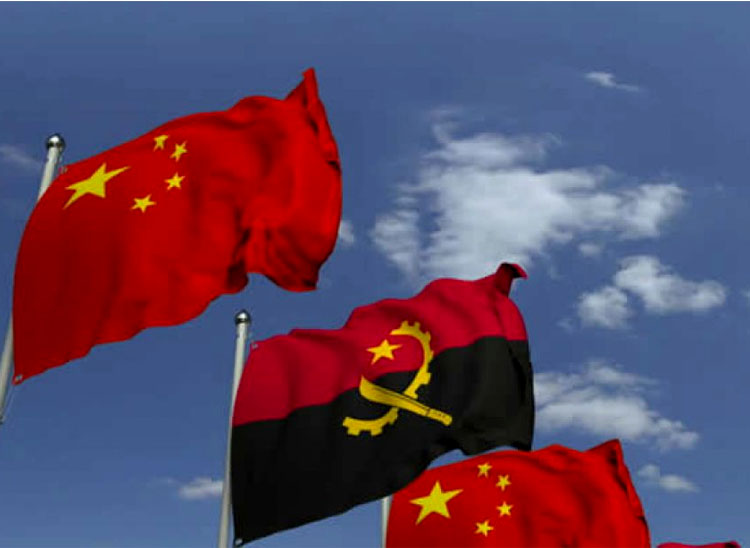Background of resource-rich Angola:
Falling into the category of ‘richest poor countries’, Angola, located on the Western Atlantic Coast of Southern Africa is home to massive quantities of oil and gas deposits, gold and diamond reserves, minerals such as iron ore, manganese, copper, platinum, nuclear energy sources such as uranium etc. However, with conditions of abject poverty impacting over 54% of the rural and 32% of the urban population[1] and a constant tussle with economic adversity, Angola is a classic example of the phenomenon of the ‘natural resource curse’ whereby a country fails to translate its natural resource wealth into better economic conditions and development. However, this is largely the case for post-colonial states like Angola which remained under the yoke of exploitative Portuguese colonial rule until 1975.
Angola’s poor economic conditions and standard of living also stem from the volatility of its political condition and almost three decades of unrest (1975-2002) owing to the post-independence civil war between the National Front for the Liberation of Angola (FNLA), the National Union for the Total Independence of Angola (UNITA), and the Marxist Popular Movement for the Liberation of Angola (MPLA). While the conflict was to a certain extent driven by ethnic and identity politics, it stood out as one of the areas of proxy conflict during the Cold War with foreign powers such as the USA, Soviet Union and Cuba providing support, training and funding to the different adversaries. Gradually, the conflict morphed into a resource competition between conflicting powers for control of diamond and oil sectors. The devastating nature of the Angolan civil war caused widespread human tragedy (1.5 million people died, 4 million faced displacement and 500,000 fled the country) and economic casualties decimating agriculture as a livelihood option for Angolans perpetuating cycles of poverty and lack of access to essential services.[2]
China’s role as Angola’s Post-Conflict Recovery Partner:
Angola’s post-war reconstruction was boosted by a meteoric rise in oil production translating into rapid GDP increase and economic growth in the country. Statistically speaking, oil production accelerated from 44.6 million tonnes in 2003 to 92.2 million tonnes in 2008.[3] During this period, China emerged as the largest importer of Angolan oil and began its infrastructural engagement in Angola marking the onset of the latter’s economic dependency on China henceforth. Gradually, a preferential pattern of seeking loans and financial investment from China over global monetary institutions was demonstrated by the Angolan political leadership. Conversely, Chinese loans were extended to Angola against conditionalities such as favouring Chinese companies in infrastructure re-development and changes in domestic labour regulations to fit the needs of such companies. Subsequently, Angola became a hub providing employment to cheap, un-skilled labour, particularly international migrant workers. It has been noted that the local Angolan labourer population working in infrastructural projects led by Chinese companies encounter poor working conditions and institutionalized maltreatment.[4] Angola witnessed the creation of pockets of wealth particularly, its capital Luanda due to the oil and construction boom. Nevertheless, this form of economic progress was largely disengaged from the needs of the local Angolan population and widespread income inequalities persisted.
Mining in Angola:
Angola’s mining industry holds potential due to its resource richness. Due to Angola’s extensive diamond reserves, diamond production accounts for a sizable portion of Angola’s mining activities and government revenue. However, the practice of diamond mining is marked by illegal mining activities, human rights violations, child slavery and smuggling. In fact, ‘blood diamond’ mining has been prevalent in Angola since the Civil War where natural resource extraction was used as the means to fund war efforts.
Due to China’s growing domestic resource needs, it has been vying for access in mineral-rich countries like Angola. In 2011, China initiated its entry in the diamond industry of Angola through Sonangol International[5]; a joint venture between the Angolan state corporation and Chinese private investment; a commercial venture which served to increase the Chinese government’s reach in Angola.
More recently, the local government has been emphasising on diversification of mineral extraction to reduce dependence on a diamond and oil fuelled economy. Accordingly, China’s Sociedade Niobonga – Comércio Geral is set to begin mining niobium in the southwestern region of Angola; a mineral used in the construction of spacecrafts, missiles, power-plants etc. [6]
China’s Oil Interests in Africa and the case of Angola:
Occupying the position of third largest oil supplier to China in 2019[7]Angola served as a suitable avenue for Chinese energy interests in the African continent. China had long been striving for oil access in Angola for energy and strategic interests (China could gain access to oil routes and SLOCs via the Angolan coast). An early example of this ambition was the Angolan Defence Minister Kundy Payhama’s visit to Beijing in 2000.[8]
The primary attraction for Chinese investment in Angola after the civil war were oil against loans and infrastructure deals. China’s entry into the Angolan oil sector was initiated with Sinopec, the Chinese oil giant purchasing stakes in oil blocks across the country and establishing a partnership with Sonangol, the state oil corporation in 2004. [9] The centrality of oil as a determinant factor in the China-Angola relationship is illustrated by the fact that China gradually surpassed all other players in the Angolan oil market to become one of the largest importers. Moreover, due to its strategic ambitions in Africa, China displayed a tendency of prioritising oil trade with Angola over its other long-term partners. Oil deals proved extremely lucrative facilitating the development of ‘petro-elites’ and by February 2006, Angola accounted for 13% of Chinese oil imports dethroning Saudi Arabia as its primary oil supplier. The oil for infrastructure arrangements continued to be preferred by both countries until the 2015 oil price decline which pushed the Angolan petrostate into economic recession. Nevertheless, China’s stake in the oil sector of Angola remains critical to this bilateral dynamic.
Neo-colonialism or Development Partnership? Contrasting Narratives:
China’s ambitions regarding African states have been the subject of much analyses and debate in international studies. China’s stance of a ‘developmental approach’ towards Africa is often met with scepticism. China’s lending practices of large loans to African countries such as Angola, Ethiopia, Sudan etc. raise questions regarding the risks of a possible debt crisis by increasing debt burdens on lesser developed African countries. Moreover, China makes economic and political gains by creating ‘debt-trap’ situations. Chinese presence in Africa also involves the influx of Chinese corporations to undertake large-scale infrastructural development initiatives in various sectors. In the case of Angola, diamond mining, crude oil and construction is where Chinese interests lie. However, such infrastructural projects seldom produce tangible benefits for the people of those countries as seen in the case of Angola.
Therefore, it has been propounded that China’s strategy in Africa involves a pragmatic combination of its strategic and political ambitions along with its business interests. Increasing Chinese economic and soft power influence across Africa delineates a new brand of ‘neo-colonialism’ encapsulating policies which enable China to exert greater control over the political, economic and security dynamics of its ‘partner countries’ in pursuance of its interests as a world power. China is believed to accomplish this through economic cooperation, trade partnerships and investment in states with relatively lesser bargaining potential in the international sphere.
Nonetheless, contrarian perceptions of China’s actions in Africa are favourable to China’s influence and developmental initiative. According to a survey, 63% of Africans across 39 nations considered China’s influence in Africa to be positive.[10] More so, China emerges as a viable alternative for investment, loans and economic cooperation which is believed can boost economic growth without the imposition of strict conditionalities. Ultimately, the rhetoric is one of contrasting narratives to viewing China’s aims in Africa.
Current Situation in Angola:
Angola has continued to grapple with economic recession since the lowering of oil prices in 2015; the oil sector which accounted for about 95% of the export share and one-third of the GDP has exhibited a vivid decline according to World Bank data[11]. With the onset of the global pandemic in 2020, Angola’s trend of negative rate of growth only accelerated. The economic decline has exposed China’s potential play of “debt-trap diplomacy” vis-a-vis Angola. Angola is presently one of the largest borrowers from China in the African continent; between 2000-2019, Angola’s debt to China amounted to 42.6 billion USD which was repaid via oil exports.[12] Reductions in oil exports thus, automatically threatens the Angolan government’s debt sustainability.
The continued period of economic downturn has brought to the fore the need for economic diversification and reducing dependency on an oil-driven economic model by boosting non-oil sectors post-2022 as oil prices are witnessing a hike. Moreover, Angola remains astonishingly behind in other development parameters such as nutrition, healthcare access, education, gender equality etc. in addition to income disparities. Despite being priority areas of development, state focus on improving these developmental aspects has been negligible.
Conclusion:
While the question of whether Angola is a means to the fruition of China’s geopolitical ambitions in Africa and the potentiality of its impact worldwide remains a prominent topic in international politics, it must be comprehended that due to a weak state structure, the ramifications of a destructive civil war and a strategy of ‘putting all eggs in one basket’ in its search for global partners, Angola has evolved as a state with major dependencies on China. China as a development partner and a creditor appears to be indispensable for Angola, at least in the immediate future. Additionally, Angola now faces greater competition from other countries which act as oil suppliers to China such as Brazil, Russia, West Asia etc.
Acknowledging the increasing debt to China and recession conditions, the new political leadership of Angola may attempt strategies to reduce its reliance on China although that would imply major structural changes in Angolian politics and economy. As such, moving ahead, Angola is encountering a complex challenge which it is largely unequipped to tackle at this juncture: the challenge of balancing its dependency on China for economic investment and the need to develop a growth model prioritising its local population who have been at the outskirts of the China-aided development strategy incessantly.
[1] Poverty & Equity Brief, Sub-Saharan Africa, Angola,World Bank Data Bank, (2020), https://databank.worldbank.org/data/download/poverty/33EF03BB-9722-4AE2-ABC7-AA2972D68AFE/Global_POVEQ_AGO.pdf.
[2] Chakrabarty, Malancha. “From War Zone to China’s Poster Child, to Economic Despair: Angola’s 40-Year Journey”. ORF Issue Brief No. 438, (2021), Observer Research Foundation, https://www.orfonline.org/research/from-war-zone-to-chinas-poster-child-to-economic-despair-angolas-40-year-journey/.
[3] Chakrabarty, Malancha. “From War Zone to China’s Poster Child, to Economic Despair: Angola’s 40-Year Journey”. ORF Issue Brief No. 438.
[4] Meyer, Patrik K. “China Is Carelessly Losing Its Soft Power Battle, One Project at a Time”. The Diplomat, (2017),
[5] “Diamond mining in Angola: Enter China and South Africa”, Polity, (2011), https://www.polity.org.za/article/diamond-mining-in-angola-enter-china-and-south-africa-2011-07-19.
[6] Chinese-owned company to begin mining niobium in Angola, Permanent Secretariat of Forum for Economic and Trade Cooperation Between China and Portuguese Speaking Countries (Macao), (2021),
https://www.forumchinaplp.org.mo/chinese-owned-company-to-begin-mining-niobium-in-angola/.
[7] “China, Oil, and Africa: A New Perspective”. Insight Turkey, Winter 2019, Volume 21, No. 1, (2019),
https://www.insightturkey.com/commentaries/china-oil-and-africa-a-new-perspective.
[8] China’s Energy Footprint in Africa- Manual Report, Institute of Developing Economies Japan External Trade Organization (IDE-JETRO), https://www.ide.go.jp/English/Data/Africa_file/Manualreport/cia_07.html.
[9] Zao, Shelly. “The China-Angola Partnership: A Case Study of China’s Oil Relations in Africa”. China Briefing, (2011),https://www.china-briefing.com/news/the-china-angola-partnership-a-case-study-of-chinas-oil-relationships-with-african-nations/.
[10] Albert, Eleanor. “China in Africa”. Council on Foreign Relations, (2017), https://www.cfr.org/backgrounder/china-africa.
[11] The World Bank in Angola, Angola Overview- https://www.worldbank.org/en/country/angola/overview#1.
[12] Nyabiage, Jevans. “Why Angola struggles to shake off its economic dependence on China.” South China Morning Post, (2021), https://www.scmp.com/news/china/diplomacy/article/3155193/why-angola-struggles-shake-its-economic-dependence-china.
Shivangi Basu, 18/08/2022

